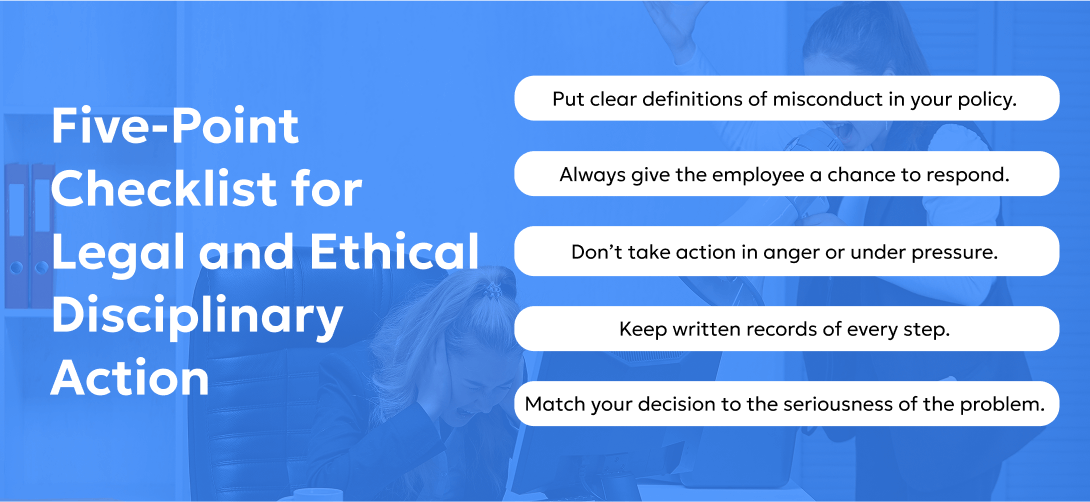
Table of Content
Can your company defend every disciplinary action in a court if it came to that?
In India, a lot of people confuse disciplinary action with punishment. But really, it’s about following a legal and fair process to maintain discipline for employees while ensuring legal compliance. Many businesses just issue verbal warnings or go with gut decisions. But if it’s not backed by the process, even a fair action can be challenged.
In one real case, a leading forging company terminated an employee who was repeatedly found sleeping on the job. Instead of acting on impulse, the employer issued warnings, conducted a proper inquiry, and maintained full documentation. The matter eventually reached the Supreme Court, which upheld the company’s decision, primarily because the correct procedure had been followed.
In this blog, we’ll cover how to take disciplinary action against employees in a legally sound way, including:
Indian Labour law, particularly the Industrial Employment (Standing Orders) Act, 1946 says you need to be fair, keep records, and give the employee a proper chance to respond. Skipping this process can land you in legal trouble, even if you’re right.
Your disciplinary process must follow laws like the Industrial Employment (Standing Orders) Act, 1946 and state-specific Shops and Establishments Acts.
These rules explain what counts as misconduct and say that every worker should get a fair hearing. This is called “natural justice.”
You also need to consider laws like the Payment of Wages Act, 1936 and the Industrial Disputes Act, 1947—especially if you’re cutting wages or terminating employment. Following this helps protect both your side and the employees.
The action you take should depend on how serious the issue is. Whatever you choose, it must be fair, written down, and part of your company policy.
Here are common disciplinary actions used by companies in India:

It’s important to follow a clear, step-by-step process when taking disciplinary action. Missing even one step can turn a strong case into a weak one—courts may reverse your decision if the process isn’t fair. Below are the key stages every employer should get right.
Here are the basic steps most companies should follow:

The employee took the case to court. Both the Labour Court and High Court said the firing was wrong. But in 2005, the Supreme Court said the company was right. Why? Because the company followed all the steps: notice, inquiry, and documentation.
This case shows why the process is everything. Even if an employee messes up, if you don’t follow the rules, you could lose in court. That’s where Vishaal Consultancy Services comes in—to help you get every detail right.
Having a clearly defined disciplinary policy for employees in India is crucial to avoid legal complications. It helps keep expectations clear and decisions fair.
Here are five quick checks to follow when handling disciplinary action:

Workplace issues can feel messy, especially when legal steps are involved. But you don’t have to deal with them on your own. We help you stay legally safe without getting stuck in paperwork.
From notices to final decisions, we guide you through every step in plain language. We assist companies in drafting a disciplinary policy for employees in India that aligns with labour law and offer Labour Law Advisory as part of our Virtual HR Services. We focus on what’s practical, not just what sounds good on paper.
Our team helps you build systems that actually work day-to-day. With Vishaal Consultancy Services, you’re not just compliant—you’re confident.
Disciplinary action against employees isn’t about punishing people—it’s about protecting your workplace values, one decision at a time. When done right, it helps teams stay strong and systems stay fair.
But don’t wait until things explode or end up in court. A little guidance now can save you major stress later. If you want help sorting through the steps or just need clarity on what’s legal and what’s not, Vishaal Consultancy Services is just a call away.
We at Vishaal Consultancy Services are here to walk with you at every step. From writing policies to handling exit paperwork, we help enforce discipline for employees in a respectful and legal manner.
Have a tough employee issue? Let’s sort it out together.
See Related Blogs
Fill in your details to download our exclusive e-learning document.
Fill in your details to download our exclusive e-learning document.
Fill in your details to download our exclusive e-learning document.